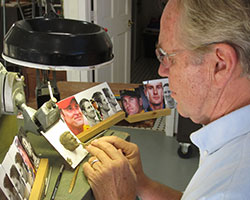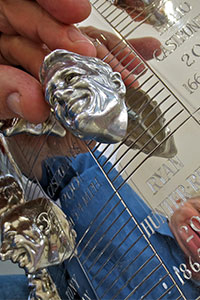The man behind the faces on Borg-Warner Trophy
DEC 03, 2014
For the next 10 months, William Behrends will enter his studio and greet the egg-size clay model of Ryan Hunter-Reay’s face with a resounding “top of the morning to you.”
It’s an act regularly repeated earlier this year to Tony Kanaan and previously Dario Franchitti, Dan Wheldon and all the Indianapolis 500 Mile Race winners dating to Arie Luyendyk in 1990.
That’s when Behrends, a renowned portrait sculptor, was commissioned to produce the sterling-silver bas relief image of the winning driver that is annually affixed to the Borg-Warner Trophy.
Click it: Ryan Hunter-Reay sees his image for the first time
On Dec. 3, Hunter-Reay’s image was the 101st to be added during a ceremony at the Indianapolis Motor Speedway Hall of Fame Museum.
So many winners have kept him company in his North Carolina studio because Behrends morphs one race champion to another from the same clay he’s been using since the beginning of the project.
 “My wife loves to watch that part of it because in the first few hours it goes from Tony Kanaan to Ryan Hunter-Reay,” Behrends said. “They have fundamentally different shaped faces; the adjustments were big ones. When I first started doing it I mixed up this clay myself to have all the properties I needed -- firm enough to work in the small detail but pliable enough to be able to work. I made up enough to do about one and a half pieces. If I had to do over again I might have mixed up a whole lot more.”
“My wife loves to watch that part of it because in the first few hours it goes from Tony Kanaan to Ryan Hunter-Reay,” Behrends said. “They have fundamentally different shaped faces; the adjustments were big ones. When I first started doing it I mixed up this clay myself to have all the properties I needed -- firm enough to work in the small detail but pliable enough to be able to work. I made up enough to do about one and a half pieces. If I had to do over again I might have mixed up a whole lot more.”
It’s the first step in a multi-pronged process to capture the personality of an individual and transform it into a three-dimensional image that is both a tribute and part of history. Photographs from multiple angles are taken of the winner the morning after the race while Behrends makes mental notes.
“The time I get to spend with the person is very valuable to me because you can see what they look like in photos but meeting them I can see their facial expressions and personality,” he says. “You get an impression of them, and hopefully it translates into this physical object I’m creating.
“I want someone who visits the trophy at the Indianapolis Motor Speedway Museum or on Race Day for the image to speak to them at a distance.”
The Borg-Warner Trophy, which is permanently on display at the IMS Hall of Fame Museum, features the face of all 98 Indianapolis 500 Mile Race winners, including two years in which co-drivers assisted the primary driver to Victory Lane, and former IMS owner Anton “Tony” Hulman.
Separate squares are reserved on the sterling-silver body on which each winner’s name, average speed and winning year are engraved to complement the base relief image. The 99th Indianapolis 500 is May 24, 2015.
 In 1935, the Borg-Warner Automotive Company (now called BorgWarner) commissioned designer Robert J. Hill and Spaulding-Gorham, Inc., of Chicago, to create the trophy at a cost of $10,000. Unveiled at a 1936 dinner hosted by then-Speedway owner Eddie Rickenbacker, the Borg-Warner Trophy was officially declared the annual prize for Indianapolis 500 victors. It was first presented that year to champion Louis Meyer.
In 1935, the Borg-Warner Automotive Company (now called BorgWarner) commissioned designer Robert J. Hill and Spaulding-Gorham, Inc., of Chicago, to create the trophy at a cost of $10,000. Unveiled at a 1936 dinner hosted by then-Speedway owner Eddie Rickenbacker, the Borg-Warner Trophy was officially declared the annual prize for Indianapolis 500 victors. It was first presented that year to champion Louis Meyer.
A sizable portion of Behrends’ catalog has been life-size statues, such as Baseball Hall of Famers Willie Mays and Juan Marichal that welcome fans to the home of the San Francisco Giants and Ben Hogan at Augusta National Golf Club. Busts include former U.S. vice president Spiro T. Agnew in the U.S. Capitol.
“If there’s been a consistent thread throughout my career is portraiture -- understanding the anatomy, the face and how to animate it,” he says. “I brought a number of years of experience to the BorgWarner project, but the smaller size does make it challenging. I didn’t work in that scale until 1990, so I found in doing it the things to make that scale work.
“I found that if I lengthened my process and added a step in the making of it to sharpen the detail and clean up the surface it reads better at a distance.”
After shaping the clay, Behrends casts it in a high-density but pliable plaster to further refine details. He then makes a mold in metal that he patiently grinds and polishes.
This year’s work marks the 25th consecutive bas relief image produced by Behrends.
“I consider it a tremendous honor to do this,” he says. “I love doing the process, and as the years go by I love seeing the collection of history and to see that I’ve had a hand in that much history is thrilling to me. When I attached this year’s image I got to look at all 25th that I’ve created and it’s thrilling to me as a progression of history.
“It’s about history and the individuals. My job is to represent that as well as possible so 10, 15, 20 years from now a person will have a good idea of who that driver was that won the biggest race in the world.
“It really is an important day when the driver sees their face for the first time. They are an important judge and I’m delighted when they are happy with their image.”























